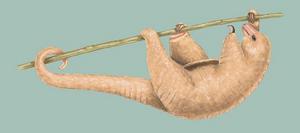The silky (also known as pygmy, dwarf, two-toed) anteater, Cyclopes didactylus, is the smallest of all the anteaters. They measure anywhere from 6 to 17.7 inches (15 to 45 centimeters) long and weigh 6.2 to 17.6 ounces (175 to 500 grams). The fur of a silky anteater is both soft and golden-brown in color. They have a short snout, 2 very long claws on their forepaws as well as a prehensile tail (meaning that the tail is able to grip onto things such as branches). Their sense of sight is poor, but both their smelling and hearing is excellent.
The silky anteater can be found from southern Mexico to Bolivia as well as Brazil. They will inhabit the Ceiba (silk cotton) tree (either alone or in pairs) due to the camouflage it provides for them. The large seed pods that these trees have contain masses of silky silverfish fiber. This is beneficial to the animal as its fur is almost identical to the sheen of these pods. A male’s territory will overlap the territory of 3 females. These animals are both nocturnal (hunting at night and resting during the day) and arboreal, meaning that they spend most of their lives in the trees and rarely venture down to the ground. When they do walk on the ground, they turn their claws inward and walk on the outsides of their feet.
The diet of a silky anteater consists of mostly arboreal ants and termites as well as the occasional beetle. They will, however, eat various fruits if insects are unavailable. They will invade ant nests and use their long, sticky tongue to obtain as many as they can, eating up to 8,000 ants per night. To obtain water, they will lick moisture, such as dew or rainwater, from leaves. Predators that these creatures must avoid include various birds of prey such as the harpy eagle, eagle-hawk and spectacled owl. When confronted by an enemy, the silky anteater will defend itself by first standing on its hind legs and grasping a branch with its hind feet and tail. It will then hold its forefeet close to its face and begin to strike with its long claws very quickly.
A silky anteater will only give birth once a year. After a gestation period of anywhere from 120 to 150 days, females will give birth to a single offspring (called a pup). Females will have their young in a nest made out of dry leaves and is located in the hole of a tree trunk. Both parents will take care of the young, with the male carrying the pup on its back sometimes. After weaning, parents will feed their young by regurgitating semi-digested insects. It is unknown how long these animals live as they are difficult to study.
The silky anteater is not considered to be in any immediate danger, although this is partly because it is very difficult to keep track of their numbers effectively. Deforestation and being captured for selling as pets are a couple of the threats they face. Hopefully, these creatures can overcome their obstacles and avoid having to face the possibility of extinction. After all, such a small and unique animal deserves to live and prosper far into the future.
Works Cited
“Silky Anteater (Cyclopes Didactylus)” 25 July 2011
“Silky Anteater” 25 July 2011
“Cyclopes Didactylus” 25 July 2011
“Cyclopes Didactylus” 25 July 2011



